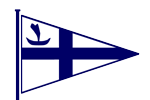History of Shanklin Sailing Club
By Les Holmberg (President)Founded in 1931, shortly after the demise of the Ventnor Sailing Club, with its four 14ft boats built locally by the Blakes of Ventnor.
The club had no premises, but a formidable group of Patrons, which included no less than three Admirals (rtd), and had a Viscount for President, R.H. Fox was elected Commodore and Dr. H.S. Howie Wood Secretary.
Records of boats sailed in the early days are vague, but were mainly privately owned scows with one club boat, but by 1936 discussion had commenced on an alternative.
Uffa Fox 12ft Nationals were considered, but finally it was decided to adopt the 12ft Exe dinghy as the clubs one-design class, and five boats were ordered by individual members for the 1937 season.
The Exe dinghy, clinker built, and ¼ decked, carried a large Bermudan mainsail on a foreward-stepped mast, had a galvanised iron centreboard and no emergency buoyancy. Kicking-straps were rudimentary and gybes, often of the Chinese variety were an occupational hazard. Due to the lack of buoyancy gear, capsizes were to be avoided, and with no headsail broaches were not uncommon when running downwind. The raised combing round the side deck made sitting-out uncomfortable.
The club operated from rented dinghy parking space at the top of “Kemps beach immediately opposite the bottom of Hope Hill.
Records for the 1937, 38 and 39 season disappeared and then came the 1939-1945 unpleasantness.
In 1946 when sanity returned, so did the desire to get sailing again, and in the February a number of surviving members got together and the club returned to life, still with no premises and still operating from Kemps beach, which was now hopelessly crowded with visitors, many having their first holiday for years.
The Exe dinghys had survived together with a few locally designed boats and were quickly into service, the 1946 season opened on 1st June, still with Viscount St. Vincent as President and now with Mr. Charlie Baker as Commodore.
All the boats were soon doing sterling service, owners generously making their boats available to non boat owning members as many returned from the “Services and joined the Club. Gradually a few additional boats appeared, including some National 12 s and another Exe dinghy was built by Clare Lallow of Cowes from lines taken off the existing boats.
It is worth remembering that at this time no purpose designed or waterproof clothing existed, (Commodore Baker, of advancing years, did in fact on occasion, sail, wearing a trilby hat and burberry raincoat). Personal buoyancy aids, other than the very occasional Mae West were not yet to come. Dinghys still had virtually no buoyancy gear, and with half hundred weight centreboards, capsizes were best avoided. Good seamanship was still a prize worth working for. Safety boats were generally not available.
In the autumn of 1946 the first post-war dinner-dance and prize-giving was well attended at Medehampstead Hotel and during the winter a program of evening lectures on sailing matters was held.
By 1949, the 12ft Firefly dinghy, designed for and used in the 1948 Olympic Games was adopted by the Club, and soon outnumbered the Exe boats, which however continued to give great service. Team racing was started within the Club and in August the first interclub team racing was held with East Cowes S.C. This enabled team members, in away fixtures to sail other classes of boats, for example on the first occasion, the East Cowes Sharpies.
In September 6 Fireflies sailed round to Ventnor and put on a days racing to encourage the reformation of the Ventnor Club. Uffa Fox, boat designer, was in attendance and sailed one race.
At the 1950 A.G.M. it was decided to delete the word Amateur from the Club title and preparations proceeded on the first club premises.
By now buoyancy, in the form of built in tanks and/or P.V.C. bags was appearing in most new dinghy classes, which whilst adding to safety tended to reduce the premium on safe sailing and good seamanship. P.V.C. smocks had made their appearance.
The new prefabricated timber club hut, on stilts over the dinghy park on Hope Beach was built and in use for the season, with its balcony for the race officials and with its flagpole and starting cannon in place.
Inter-club racing continues with East Cowes S.C. and contact has been made with the newly formed Brading Haven Y.C.
By 1951 team events were being held with East Cowes, Brading Haven and Wootton Creek (later to become Royal Victoria) clubs and throughout the decade both Fireflies and
Exe boats continued to give great service, racing on average on three or four occasions each week.
Club membership ebbed and flowed as members aged or left the area for educational or employment reasons, but throughout a hardcore remained, including a number of founding members. Uffa Fox became an honorary life member; Gurnard S.C. joined the clubs involved with us in interclub racing.
With 1953 approaching news filtered through of a proposed Round the Island Dinghy Race for boats of 14ft and upwards. One club Firefly, having sailed alone around the Island in just over 9 hours during 1952, the crew of this boat approached the organisers, and over dinner obtained agreement for Fireflies and 12ft Nations to be included. The event, held on Coronation Day was a great success, with 2 Fireflies from Shanklin S.C. participating.
Sadly in 1954, we lost through death, both our President Charlie Baker, and Rear Commodore Clive Preston, who died in his dinghy in Bembridge Harbour.
As the decade ended, the appeal of the Exe boats declined, and the Firefly owners began to feel a need for a change. Fortunately the slightly larger and relatively inexpensive Enterprise had arrived on the scene and had proved itself by making Channel crossing to France.
In 1958, 2 Prout Shearwater Catamarans, built from kits by 2 members made their appearance and proved an interesting but not very successful experiment. One did however sail subsequently to Bognor for the class championships and obtained 11th place in class. The same boat later cruised to Brighton and back.
The season, due to the collapse of the Firefly class, was one of mainly hadicap racing. Next season, 1959, will see the Enterprise class racing in the bay, and at long last as the decade ends, the omens are better for obtaining agreement with the local council for a site for a larger clubhouse and off beach dinghy parking.
The 1959 season as hoped, saw the start of Enterprise one design racing, although as the season progressed suspicion dawned that some builders built a better boat than others. This season also saw the inclusion of Silver Wings S.C. (British European Airways) on our interclub team-racing list. The away fixture, on a 100acre, flooded gravel pit at Datchet, providing an unusual venue. Fixtures with our usual other clubs continued, sometimes interrupted by adverse weather, and as so often the case, spring tides at the end of the season brought gales, which necessitated hurried forays to get boats off the beach and onto the Esplanade in the middle of the night. The Ladies Committee continue to be of great value in raising funds, and providing refreshment, particularly for home interclub events. Although negotiations continue, we still have been unable to obtain a site for the proposed clubhouse and or dinghy park. Mr. (Squire) Herbert Fleming continues as Commodore and Dr. Howie Wood as President.
The 1960 season started where 59 had ended, still with no agreement from the Coucil regarding the new sites. Building the 1951 Festival of Britain must have been childs-play compared with the indecision experienced from the local authority.


